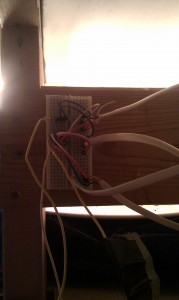To really be able to measure the effects of putting all that energy into our floor, and also see how long it takes before the room starts warming up, we need some temperature sensors.
I started with a LM35D sensor (analog) which I placed outside to measure the outside temperature. This started pretty well and after putting the weather station thermometer in the same location, the readings were equal. However, it got colder and colder here and after a night with some good frost, I expected to see ‘minus’ something. But I wasn’t 🙂 After reading up the data sheet I noticed that the LM35D sensor has a range of 0 to 100. Typical!
No problem, so I put the sensor in our living room to monitor this. But from the measure point to the arduino it is about 18 meters. After a quick test and some searching on internet I came to the conclusion that for these analog sensors it is best to have it within a 1 – 2 meter range (max wire length) and what I wanted was not very smart.
To solve this we need to go digital. I ordered some DS18B20 sensors and after a few weeks wait (ordered from dx.com) I got them. In the meantime I had also ordered my 3rd arduino (from ebay) to have a spare to do some testing with so that I don’t need to interupt the gas or power arduino’s.
After downloading the OneWire and Dallastemperature libraries it was very simple to set it all up.
I ended up including the sensors on the gas meter arduino as that board is not always running and interpreting data. Power keeps going 24×7 and want to keep as accurate as possible.
The code for reading the sensors I used are as per samples from the libraries and incorporated this in my Gas sketch. With the analog sensor I was reading the sensor multiple times and averaging to get more consistant readings, but my experience with these digital ones is excellent. Only had 2 or 3 bad readings (on in total 5 sensors). I have put sensors in living room, our central heating machine (watertemp return to boiler and water temp exit boiler), outside temp, our home office room.
On our gas stoked boiler for the central heating I have put 2 sensors on the water pipes that go back into the boiler, and leaves the boiler. Taped them on with some duck-tape and then put some insulation around them both for more accurate readings.
I have all temperature sensors coming into 1 breadboard and putting these with 3 wires and a 4.7 kohm resistor to ground, power and digital input 2 to read. I can really appreciate the fact that all the sensors have own MAC address to help identify, and also have multiple sensors on 1 wire! Nice.
The longest distance from sensor to arduino is approx 18 meters. To bridge this distance I used telephone (installation) wire. This is also working well.



